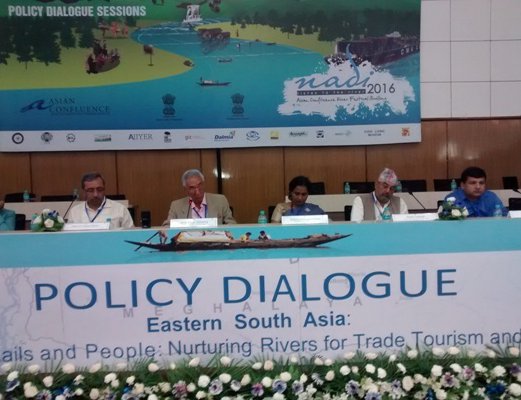
If political leadership of Nepal, Bangladesh, India, Bhutan and Myanmar hear the voices from the grassroots, the people living in these countries can use the rivers to do their travel and trade in the region better.
Because of the many restrictions on mobility and navigation, the people of this region are too close, yet too far. With the neighbors first foreign policy and development of northern Indian states as a priority, Indian Prime Minister NarendraModi is stressing the need to increase the connectivity in the region.
“As India’s northeastern states and her immediate neighbors, Bangladesh, Bhutan, Nepal and Myanmar are geographically compact in eastern South Asia, they can come together to accelerate the economic growth,” said SabyasachiDutta, program director, NADI 2016, the Asian Confluence River Festival of Shillong.
With immense economic prosperity, the linking of this region through rivers will not only bring better prospects for the people but also change the economic landscape of the region.
With hundreds of rivers that link North East India and her neighbors, the common stand on the use of rivers and protection of ecosystem and fauna and flora is of great importance.
With the Indian government spending a huge amount of money to improve the water ways, future of connectivity of the region will be different. According to studies, river transport is the cheapest among all forms of transport. Carrying the goods through ship is 100 percent cheaper than the same by railways.
Given the current emphasis, it may not be too far to see the ship coming up to the mouth of the Kosi river in Sunsari from the Bay of Bengal or Chitagaon of Bangladesh or Guhati of Assam. Before submerging to the Bay of Bengal, all the major rivers of the region, including Ganga and Brahmaputra, meet in Bangladesh.
Similarly, other states of northeast India, including Arunanchal, Tripura, Assam, Mizoram and Meghalaya, will get the immediate benefits. Along with Bangladesh and northeast, Bhutan will also benefit, as will Myanmar.
For centuries, tributaries of Ganga and Brahmaputra rivers have been linking the people of Nepal, Bhutan, India, Myanmar and Bangladesh. People living in this region share not only the prosperity thanks to the rivers but also destruction.
With the stoppage of the river navigation and movement, the rivers are just a source of pain to the people of the region. In place of the potential to provide enormous economic advantages, these rivers are seen as a force of destruction during the rainy season.
Instead of being the signs of prosperity, the rivers symbolize pain and destruction for many a people. In the past, these rivers were used to ferry goods and people linking and sharing each other’s trade and culture.
Rivers have been flowing there for centuries, changing their courses and supporting the partition of India. “Although our region is closely connects via Bangladesh, we have to cross hundreds of kilometers to come across the region,” said JitendraChoudhary, MP Tripura. MP representing the constitution of Cachar of Assam Sushmita Deb holds the view that the time has come to use the rivers to bring the change in the livelihood of the people.
“The connectivity through the river will bring prosperity in the region,” said MP Chaudhary.
Despite the close connectivity through the rivers, people living in the region have lived in isolation for a long period of time preventing the transportation of goods and people through the river channel.
“This is a major breakthrough as the politicians, government officials and other stakeholders have started to speak the real voice. Nepal has been saying this for quite a long time to open major rivers for water ways,” said former water resources minister of Nepal Deepak Gyawali. "This is a good beginning.”
Organized by Government of Meghalaya and North Eastern Council, the program had ministers, government officials, experts and other stakeholders gathered in the NADI 2016, the Asian Confluence River Festival Shillong. They held the view that the time has come to revive the connectivity through the major rivers which naturally connects the region.
Bhutan’s former minister Dago Tshering said connectivity through the rivers is very important for a country like Bhutan as it will reduce the cost and save time in carrying the goods.
Inaugurated by chief minister of Meghalaya MukulSangma, Tourism Minister of Bangladesh Rashed Khan Menon said that his country has already signed a river connectivity accord with India to provide transit to northeastern state.
Although India’s north eastern states are closer from Bangladesh and the river navigation can reduce the cost of the materials and other goods drastically, they have yet to have a regular connectivity. With no connectivity through Bangladesh, the cost of products carried to Indian states through West Bengal is huge.

Keshab Poudel
Poudel is the editor of New Spotlight Magazine.
- FOURTH PROFESSOR Y.N. KHANAL LECTURE: Nepal-China Relations
- Jun 23, 2025
- Colonel JP CROSS: Centenary Birthday
- Jun 23, 2025
- REEEP-GREEN: Empowering Communities with MEP
- Jun 16, 2025
- BEEN: Retrofitted For Green
- May 28, 2025
- GGGI has been promoting green growth in Nepal for a decade: Dr. Malle Fofana
- May 21, 2025












